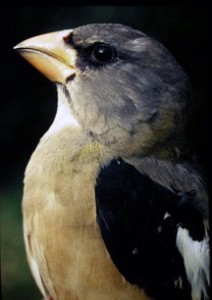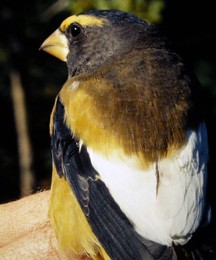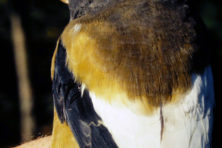Evening Grosbeak
- Share
- Tweet
- Pin
- Share

Over two-dozen Evening Grosbeaks eat sunflower seeds peacefully together.
Up to the time I began teaching in Madison in 1955 I had barely heard of an Evening Grosbeak, nor had I ever seen one. My first Evening Grosbeak seen in Kewaunee County was during our Christmas Bird Count (CBC) on Dec. 28, 1958, but the year prior I first encountered this large-beaked species.
It was on one of my late fall weekend visits to Kewaunee to see my parents in 1957 that I came to know the Two Rivers High School biology teacher, John Kraupa, who invited me to accompany him to search for a few bird species that had arrived in the area to spend the winter. The first was a Northern Shrike seen below the dam at Shoto, and next we headed for Mishicot in Manitowoc County to watch Bernie Brouchoud trap and band Evening Grosbeaks – a “lifer,” or new bird to add to my life list of those seen.
The Evening Grosbeaks were feasting on one of their favorite winter foods, seeds from the huge Boxelder trees, referred to as Manitoba Maples in Canada, which virtually lined the banks of a small river. It’s always exciting for me to add a “lifer,” but that visit was special because Bernie became a good friend of mine, and still is. It was he who sparked my interest in finally obtaining my federal bird-banding license in 1962.
Eventually, I came to know Henry and Edna Koenig, famous and expert songbird rehabilitators and banders from Sauk City, Wis. From January 1 to May 6, 1962, during the first really big and well-documented invasion of Evening Grosbeaks into Wisconsin, the Koenigs captured and banded 1,302 of them at their home. Forty of those captured were recoveries of birds that other banders had banded. One had been banded in 1954 in New Hampshire. Others had been banded and released in Ontario, Vermont, Connecticut, New York, Maine, Massachusetts, Pennsylvania, Minnesota and Virginia. It was while watching the Koenigs band those “large-beaked” birds that I realized how hard they can bite, easily capable of causing one’s fingers to bleed.
These downright glamorous and exciting birds, as Sam Robbins described them in his great Wisconsin Birdlife book, always have been highly irruptive and difficult birds to study. Prior to the late 19th century the Evening Grosbeak did not occur east of the Great Lakes. Since then they have expanded rapidly across Ontario, Michigan, Quebec, and Canadian Maritimes and New England. They are primarily birds of the boreal (northern) and montane (mountain area) forests. Their numbers were fairly stable, at times increasing, until 1980.

A female Evening Grosbeak, held by Roy, eyes the next finger to bite.
For many years their numbers have tended to be on a two-year cycle, up one year, down the following with the cause of decline relatively unknown. In recent years it has been obvious that these grosbeaks are not moving as far south during the winter, possibly due to the trend in warmer winter temperatures. Their decline also may be related to food availability. Seeds of hardwoods, especially maple and ash, are among their favorite foods.
Nestlings of these grosbeaks, along with other birds, need protein, and it has been known for many years that the Evening Grosbeaks’ common food during nesting has been the Spruce Budworm (larvae). A study made during 1962 through 1964 in Quebec involved the Evening Grosbeaks and a heavy infestation of the spruce forest-damaging Spruce Budworms. These caterpillars were doing great damage to a particular forest and at the same time were attracting large flocks of the grosbeaks, which in turn were feeding upon them.
Two bird banders during 11 days of June that first year, using two small “potter” traps, trapped and banded 747 grosbeaks there. Shortly after that, the Quebec Department of Forestry sprayed this forest with DDT. The following June during the comparable 11-day period, only five grosbeaks were captured. One year later no grosbeaks were caught in that same forest. The Evening Grosbeaks quite possibly would have succeeded in controlling the infestation of Spruce Budworms without man’s “dangerous” help, and this is not the only injurious insect pest the Evening Grosbeaks are known to relish.
What’s interesting is that I moved into The Ridges Rangelight Residence in the summer of 1966, and that winter plenty of Evening Grosbeaks were reported from throughout the state, including my backyard. For the following eight or nine years these flashy black, white, olive and yellow birds were one of our winter highlights, regardless of the quantity of sunflower seeds they ate.
Charlotte and I kept track of the number of 50-pound bags of sunflower seeds we bought one year, and the total was 44. That’s 2,200 pounds – over one ton! At that time we were estimating that our daily flock of grosbeaks numbered around 300. Fortunately Bob Schultz Sr., owner of the Baileys Harbor Feed Mill, sold them to me for $6.50 a bag as long as I bought 10 bags at a time. How times have changed!

The male Evening Grosbeak has more sharply contrasting yellow, white and black in his plumage.
Through all 48 years that we’ve kept careful track of birds seen each year in our county, only once did I see a pair of Evening Grosbeaks in summer. They were known to nest commonly in the Upper Peninsula of Michigan, mostly in second growth Balsam Fir and spruce woods that were fairly near to hardwoods.
Our Northern Door County CBC of 1972, which was the year of our first big flock at The Ridges, 433 Evening Grosbeaks turned up. Our Northern Door CBC of 1975 had 364 grosbeaks. 1978 was another high year with 459 counted. Our high CBC total of Evening Grosbeaks was in 1980 with 669 counted. Gradually their numbers dwindled, with 137 in 1989 and only three in 1990. We tabulated 164 on our 1995 CBC and 15 in 1997, bringing to an end a good many years of enjoying the “big-beaked” winter seedeaters in Door County.
Is this possibly a population cycle that lasts several or more decades? Does such a fast population decline warrant serious study? Other states, including Minnesota, are also noticing serious declines. Unfortunately these birds are very difficult to study due to their highly secretive nature when nesting and also to the fact that they wander widely and unpredictably.
A report from the bird experts in Ontario says that some Evening Grosbeaks can be expected at feeders in central Ontario this winter and probably elsewhere in the Northeast because coniferous and hardwood tree seed supplies are very low this fall. Whether or not small numbers of these welcome birds will reach our region remains to be seen.
Our friend of years ago, Emma Toft, thoroughly enjoyed these flashy colorful winter visitors in past years, saying that they reminded her of the black and yellow Canadian Tiger Swallowtail Butterflies of summer. We’re ready for the Evening Grosbeaks with open arms – and plenty of sunflower seeds.


